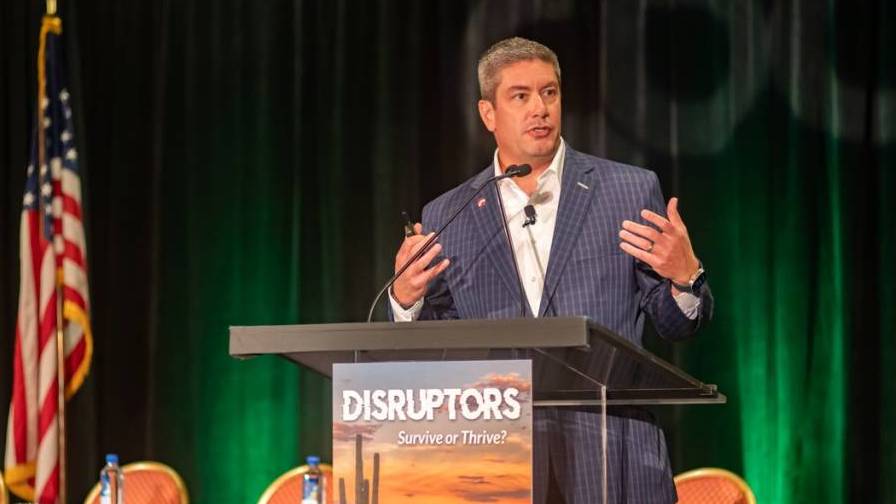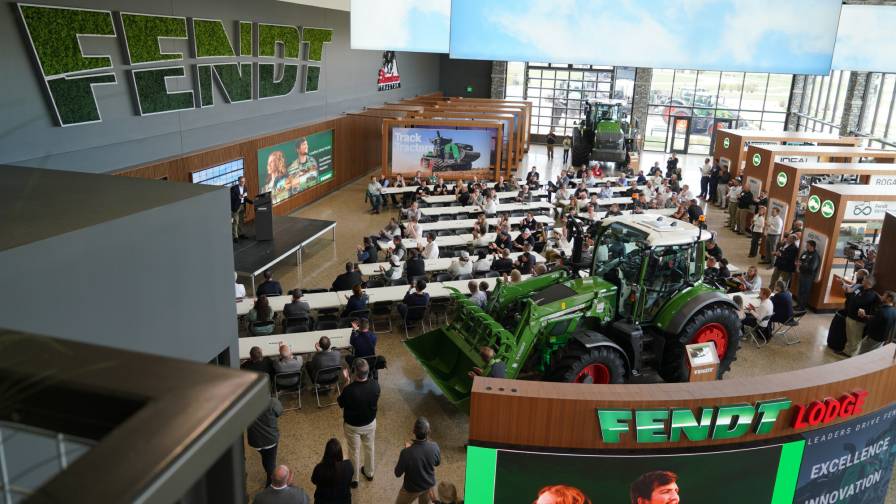Precision In Action

Corn is the main crop here, accounting for 90% of their acreage. Once it was just 50% to 60%, but with the higher price for corn and the crop insurance guarantee being much better than on soybeans, it only makes sense to them to plant corn. “It is easier for us to raise corn than soybeans for yield potential, especially with pivots,” says Nuest. “We figure we are going to average 175 to 180 bushels of corn per acre, and it’s not hard to get 200. Soybeans are going to be 45 to 50 bushels an acre and not much better than that. The economics of corn are a lot greater. It’s a lot more work, but it’s a lot more profitable.”
The work begins in the field cultivating the soil. The weather is such in this area of the country that the ground does not warm up as much if the residue is left in the field reflecting the sun. The corn doesn’t grow as fast, and it affects the yield. The Nuests plow the field with a conservation moldboard plow that stands the soil up with some of the residue sticking up.
A Mid-April Start
Planting begins around April 25 and takes six to seven days. The Nuests use the Topcon X20 on their planter to drive the tractor and for variable-rate planting. It shuts off the planter row units over planted areas and when it gets to the end of the field. It also allows the growers to control the seed population. At the center pivot areas and on the corners where the irrigator doesn’t hit, they can reduce the population from 37,000 plants per acre to 20,000.
“It has saved us,” says Nuest. “I ordered seed this year for planting 37,000 plants across the farm. We returned 94 bags of seed. That’s about $15,000 worth of seed saved because of variable-rate planting. It’s not going to affect our yield at all. Our yield potential is the same. It just saved inputs.”
Irrigation Issues
All irrigation on Nuest Farms is accomplished using pivots. The 19 pivots get water from 25 wells. A few pivots require multiple wells because the makeup of the soil structure does not allow enough water to be drawn from some of the shallow wells. Well depths vary from 25 feet to 120 feet. All but one of the wells is powered by electricity at a yearly cost of about $15 to $20 per acre. The other well has a diesel-powered pump that became expensive to run in 2008.
The Nuests side-dress anhydrous (nitrogen) after the crop is up. “We’re 22-inch rows,” says Nuest. “There gets to be this time that you don’t want to start because the corn is short and you have to go slow. But if you don’t get started, it seems like you are always panicking that it’s going to grow you out of the field.”
Farm Works software is used on the farm. Yield maps from the combines are overlaid with a circle that shows the path of the pivot. The pivot point is determined from the yield maps. This is stored as a shape file and is uploaded to the hard drive in the Topcon X20 to variable-rate the planting populations.
The same map is used to variable-rate apply the anhydrous. In 2008, that resulted in a savings on nitrogen of $11,000.
The Nuests spray for weeds while the plants are small, beginning when they are about six inches tall. If a second pass of glyphosate is required, the growers like to apply it about knee-high before the plants canopy so the crop protection product can get down to the weeds. Spraying is typically finished around June 15 to 20 for corn. Soybean spraying follows and is completed by July 4.
Spraying is aided with the help of the Topcon X20. It can shut off two spray tips at a time on the 132-foot wide, 30-section sprayer. The smallest section has two nozzles, and the largest has four nozzles. This is a tremendous help on overlap.
The price of glyphosate has gone up so there is a dollar benefit. Also, overlap needs to be avoided when spraying a crop protection product that carries over to the next year. The Topcon unit controls the sprayer and shuts off areas already covered. Nuest points out this can really help with odd shaped fields or point rows.
Adding the savings in 2008 from variable-rate planting and variable-rate nitrogen fertilizing, you come up with $26,000 in hard cash savings. This does not count the savings in time, crop protection products, and fuel by not overlapping through the use of GPS technology.
Plans For The Future
This year, Nuest expects to add another $150,000 in potash and phosphate savings, plus a savings of $6 per acre application fee the growers have been paying for another $30,000 direct cash outlay savings, minus the actual cost of their application. They plan to do this with the help of the Topcon X20 and other GPS products with a process called “banding.”
Nuest believes you can variable-rate potash and phosphate effectively. The banding process allows the user to put a one to two-inch band of potash and phosphate four inches below the surface (two inches below the seed) and two inches off to the side. Nuest says: “Our goal is to band our fertilizer four inches below the surface with our planter. We will have a fertilizer cart with two boxes on it that each holds five tons. We’ll put potash in one and phosphate in the other. We’re going to blend our rate as we go. We can cut our rates 40% by banding it instead of broadcasting it and not affect our yields.”
The seed will be planted within two inches of the band, and the roots will find the band. This is possible by utilizing the X20 in combination with a RTK (real-time kinetic) broadcast signal from a known point. This combination of GPS and RTK will allow sub-inch accuracy on both the horizontal and vertical planes. The RTK transmitter will be mounted on top of the grain storage bin leg. The FM transmitter will broadcast the signal to the tractors. One tractor will e-mail Nuest’s A-B line to the next tractor. He says: “Its wild stuff. The X20 has all kinds of capabilities. It’s an amazing machine.”
How the Nuests will do banding has taken a lot of thought. First, the growers thought about putting it on the corn planter, but that would have slowed the unit down. They can plant 260 acres without stopping. The biggest fertilizer tank the growers can use will cover 80 acres, so they would have to stop planting three times. Each time they stop delays them 30 minutes, in which time they could plant 20 to 30 acres.
Looking for efficiencies, the Nuests looked at building a fertilizer bander. This would be a 36-row unit that would go ahead of the planter. The growers would lay the band down and then follow it with the planter. However, this system would require another person.
A Combination Approach
The plan at the time this article was written was to use the GPS with RTK and put the receiver on a new planter. The Nuests have purchased a 60-foot Wilrich toolbar to use to build the planter. The toolbar is mounted on tracks and has four 75 bushel poly tanks mounted on it that will hold 9 tons of fertilizer. The tanks are built by Amity. Nuest plans to use this planter to place the fertilizer in a band while planting.
The farm uses a dry insecticide for corn rootworms on 20% of the rows. It has been “kind of a hassle,” says Nuest, because the boxes didn’t empty at the same time as the planter. The Nuests are going to a liquid product this year that will direct inject it into the starter fertilizer and use the Topcon X20 to control that injection. A liquid insecticide is also used to kill aphids on soybeans.
Nuest started using Topcon products when he needed a GPS unit that would control multiple flow meters. The Nuests needed to control two units that convert anhydrous to liquid. They needed to control two flow meters with the width of their equipment, and Topcon was one of the only companies with that capability.
“Your flow meters can monitor how much is going out and can change your rate if you speed up or slow down. The same thing is true with our row crop sprayer,” he says. “Let’s say our target is 10 gallons per acre. If I’m going five miles per hour, that takes less volume to come out than if I’m going 10 miles per hour. The Topcon X20 controllers will change that as you speed up and slow down.”
He turned to Rust Sales, Harwood, ND, for his Topcon GPS equipment. Service is important to Nuest, and he says Rust Sales sales representatives can answer most of his questions over the phone.
An Expanded Pay Out
When GPS equipment first came to the farm, it only paid for itself, Nuest says: “All of a sudden, we are starting to talk dollars,” he says. “Now, this stuff pays. It’s not just a ‘gee whiz’ thing that I can sit here and not steer my tractor. Now we are talking about making this thing economical and making us some money instead of just paying for itself. It’s fascinating.”
The 53-year-old Nuest says they try to be grain merchandisers in addition to being farmers. As a former finance company manager, he has put a pencil to the cost of storage bins that he prefers to call grain handling equipment. He figures with today’s higher price for steel, a bin will take seven to 10 years to pay for itself at today’s market spread.
“We don’t have time to wait in line at the elevator for them to dump us,” he says. “We run our combine from seven in the morning until 10 at night without stopping unless we have a breakdown and when we put fuel in it. We have to do that for 25 days to get our harvest out. It runs six days. We don’t run on Sunday. We have enough wet corn on hand that the dryer can run all day Sunday.”
The grain handling capacity of all his bins will be 800,000 bushels when the current one under construction is complete.
Efficiencies allow Nuest and his wife, Connie, to take some time off to drive to Ft. Meyers, FL, to see their daughter Ashlee, who teaches senior math at a Christian high school; and their other son, Cory, who is a banker in Monticello, MN, and to spend some time with Chad and family away from work.
Efficiencies allow him to buy new equipment, to put money in his pocket, and to build a business that can be carried on by future generations, created and utilized by grasping onto the ever-improving new technology available to today’s grower.






